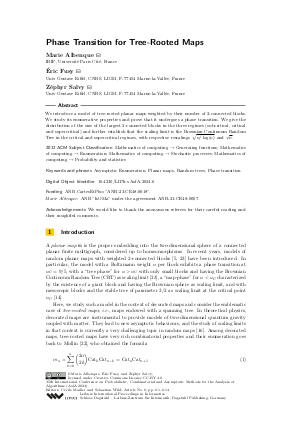Phase Transition for Tree-Rooted Maps
Authors Marie Albenque, Éric Fusy, Zéphyr Salvy
-
Part of:
Volume:
35th International Conference on Probabilistic, Combinatorial and Asymptotic Methods for the Analysis of Algorithms (AofA 2024)
Part of: Series: Leibniz International Proceedings in Informatics (LIPIcs)
Part of: Conference: International Conference on Probabilistic, Combinatorial and Asymptotic Methods for the Analysis of Algorithms (AofA) - License:
 Creative Commons Attribution 4.0 International license
Creative Commons Attribution 4.0 International license
- Publication Date: 2024-07-18
File

PDF
LIPIcs.AofA.2024.6.pdf
- Filesize: 0.67 MB
- 14 pages
Document Identifiers
Subject Classification
ACM Subject Classification
- Mathematics of computing → Generating functions
- Mathematics of computing → Enumeration
- Mathematics of computing → Stochastic processes
- Mathematics of computing → Probability and statistics
Keywords
- Asymptotic Enumeration
- Planar maps
- Random trees
- Phase transition
Metrics
- Access Statistics
-
Total Accesses (updated on a weekly basis)
0PDF Downloads0Metadata Views
Abstract
We introduce a model of tree-rooted planar maps weighted by their number of 2-connected blocks. We study its enumerative properties and prove that it undergoes a phase transition. We give the distribution of the size of the largest 2-connected blocks in the three regimes (subcritical, critical and supercritical) and further establish that the scaling limit is the Brownian Continuum Random Tree in the critical and supercritical regimes, with respective rescalings √{n/log(n)} and √n.
Cite As Get BibTex
Marie Albenque, Éric Fusy, and Zéphyr Salvy. Phase Transition for Tree-Rooted Maps. In 35th International Conference on Probabilistic, Combinatorial and Asymptotic Methods for the Analysis of Algorithms (AofA 2024). Leibniz International Proceedings in Informatics (LIPIcs), Volume 302, pp. 6:1-6:14, Schloss Dagstuhl – Leibniz-Zentrum für Informatik (2024)
https://doi.org/10.4230/LIPIcs.AofA.2024.6
BibTex
@InProceedings{albenque_et_al:LIPIcs.AofA.2024.6,
author = {Albenque, Marie and Fusy, \'{E}ric and Salvy, Z\'{e}phyr},
title = {{Phase Transition for Tree-Rooted Maps}},
booktitle = {35th International Conference on Probabilistic, Combinatorial and Asymptotic Methods for the Analysis of Algorithms (AofA 2024)},
pages = {6:1--6:14},
series = {Leibniz International Proceedings in Informatics (LIPIcs)},
ISBN = {978-3-95977-329-4},
ISSN = {1868-8969},
year = {2024},
volume = {302},
editor = {Mailler, C\'{e}cile and Wild, Sebastian},
publisher = {Schloss Dagstuhl -- Leibniz-Zentrum f{\"u}r Informatik},
address = {Dagstuhl, Germany},
URL = {https://drops.dagstuhl.de/entities/document/10.4230/LIPIcs.AofA.2024.6},
URN = {urn:nbn:de:0030-drops-204413},
doi = {10.4230/LIPIcs.AofA.2024.6},
annote = {Keywords: Asymptotic Enumeration, Planar maps, Random trees, Phase transition}
}
Author Details
Funding
ANR CartesEtPlus "ANR-23-CE48-0018".
- Albenque, Marie: ANR "IsOMa" under the agreeement ANR-21-CE48-0007.
Acknowledgements
We would like to thank the anonymous referees for their careful reading and their insightful comments.
References
-
Louigi Addario-Berry. A probabilistic approach to block sizes in random maps. ALEA - Latin American Journal of Probability and Mathematical Statistics, XVI:1-13, 2019.

-
Olivier Bernardi. Bijective counting of tree-rooted maps and shuffles of parenthesis systems. Electron. J. Comb., 14(1), 2007.

-
Olivier Bernardi. Tutte polynomial, subgraphs, orientations and sandpile model: New connections via embeddings. Electron. J. Comb., 15(1), 2008.

-
Olivier Bernardi and Mireille Bousquet-Mélou. Counting colored planar maps: algebraicity results. Journal of Combinatorial Theory, Series B, 101(5):315-377, 2011.

-
Valentin Bonzom. Large N limits in tensor models: Towards more universality classes of colored triangulations in dimension d ≥ 2. Symmetry, Integrability and Geometry: Methods and Applications, 12(073):39, 2016.

-
Gaëtan Borot, Jérémie Bouttier, and Emmanuel Guitter. Loop models on random maps via nested loops: the case of domain symmetry breaking and application to the Potts model. Journal of Physics A: Mathematical and Theoretical, 45(49):494017, 2012.

-
Mireille Bousquet-Mélou and Julien Courtiel. Spanning forests in regular planar maps. Journal of Combinatorial Theory, Series A, 135:1-59, 2015.

-
Frédéric Chapoton. The Anticyclic Operad of Moulds. International Mathematics Research Notices, 2007.

-
Jian Ding and Ewain Gwynne. The fractal dimension of Liouville quantum gravity: universality, monotonicity, and bounds. Communications in Mathematical Physics, 374(3):1877-1934, 2020.

-
Thomas Duquesne and Jean-François Le Gall. Random trees, Lévy processes and spatial branching processes, volume 281. Société mathématique de France Paris, France, 2002.

-
B. Eynard and G. Bonnet. The Potts-q random matrix model: loop equations, critical exponents, and rational case. Physics Letters B, 463(2-4):273-279, 1999.

-
Stefan Felsner, Éric Fusy, and Marc Noy. Asymptotic enumeration of orientations. Discrete Mathematics & Theoretical Computer Science, 12, 2010.

-
Philippe Flajolet and Robert Sedgewick. Analytic combinatorics. Cambridge University press, 2009.

-
William Fleurat and Zéphyr Salvy. A phase transition in block-weighted random maps. Electron. J. Probab., 29:1-61, 2024.

-
Xavier Gourdon. Largest component in random combinatorial structures. Discret. Math., 180(1-3):185-209, 1998.

-
Ewain Gwynne, Nina Holden, and Xin Sun. A mating-of-trees approach for graph distances in random planar maps. Probability Theory and Related Fields, 177(3-4):1043-1102, 2020.

-
Ewain Gwynne and Joshua Pfeffer. Bounds for distances and geodesic dimension in Liouville first passage percolation. Electron. Commun. Probab., 24:1-12, 2019.

-
Svante Janson. Stable distributions. arXiv preprint arXiv:1112.0220, 2011.

-
Svante Janson. Simply generated trees, conditioned Galton-Watson, random allocations and condensation. Probability Surveys, 9:103-252, 2012.

-
Igor Kortchemski. Limit theorems for conditioned non-generic Galton-Watson trees. Ann. Inst. Henri Poincaré Probab. Stat., 51(2):489-511, May 2015.

-
Jean-François Le Gall. Random trees and applications. Probability Surveys, 2:245, 2005.

-
R. C. Mullin. On the enumeration of tree-rooted maps. Canadian Journal of Mathematics, 19:174-183, 1967.

-
Benedikt Stufler. Limits of random tree-like discrete structures. Probability Surveys, pages 318-477, 2020.

-
Benedikt Stufler. On the maximal offspring in a subcritical branching process. Electronic Journal of Probability, 25:1-62, 2020.

-
William T. Tutte. A census of planar maps. Canadian Journal of Mathematics, 15:249-271, 1963.

